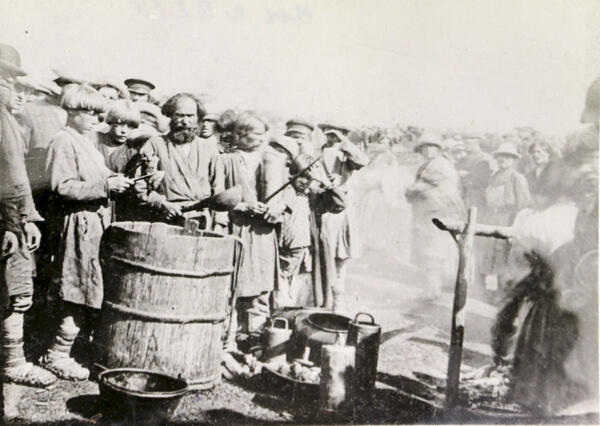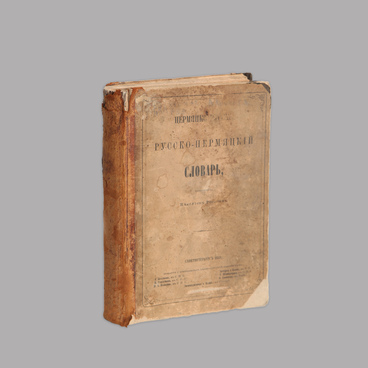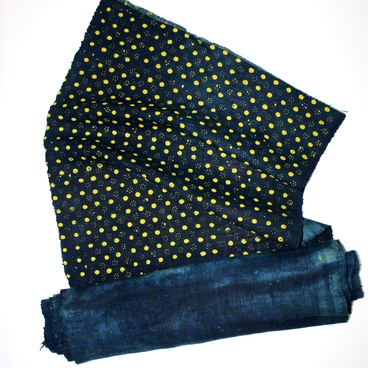The photo was taken by the painter and collector of antiquities Vladimir Alexandrovich Plotnikov who descended from a family of Permian artists. The photographer captured an old Komi-Permyak rite “Bykoboi” (bull slaughter) in the village of Bolshaya Kocha. In the foreground near a large wooden tub are men and boys wearing peasant clothes. One of the men holds a wooden ladle in his hands, a young man to his left holds a piece of meat with tongs or wooden sticks. On the ground in front of them there is a sacrificial cauldron, birch bark tubs and a keg. To the right, there is a ritual fire and a hammered-in forked pole with a crossbar.
“Bykoboi” is a traditional rite of bratchina (communal meal, from brat, “brother”) among the Komi-Permyaks. It was held on the day of Saints Florus and Laurus, the patrons of livestock. In the Komi-Permyak language this day is called Prollaver. This pagan rite survived after the Christianization of Great Perm in 1462 and is still practiced today. “Bykoboi” was traditionally held in the village of Bolshaya Kocha near the church of Saints Florus and Laurus on August 18 in the Julian calendar (August 30 in the Gregorian calendar). On this day people gathered to sacrifice a young bull.
The bulls, which turned three years old, were brought by their owners from different villages of the Perm Province. People along the route greeted them, saw them off, or joined the procession. After the prayer bells were sounded, bulls were slaughtered and their carcasses were dressed according to the ritual order: the heads were meant for God and were burned in the fire, and the hides were donated to the chapel. The fillet was given to the church, and the rest of the meat was divided equally among the people, boiled in two copper cauldrons and eaten in praise of the Lord. The moment the servings were handed out is depicted in the photo from August 18, 1908.
The Permyaks gave bulls for sacrifice voluntarily. If misfortune happened in their home, they asked God for protection to grant their wishes. Traditionally, the bull slaughter, sprinkling and praying in water took place on the same day, but if the holiday fell on a Monday, the sacrifice was made the day before. The meat had to be eaten before nightfall, because the Permyaks considered Monday a fast day. All ritual paraphernalia: cauldrons, forks, knives, and other things were kept near the chapel in a separate building topped with a cross.
“Bykoboi” is a traditional rite of bratchina (communal meal, from brat, “brother”) among the Komi-Permyaks. It was held on the day of Saints Florus and Laurus, the patrons of livestock. In the Komi-Permyak language this day is called Prollaver. This pagan rite survived after the Christianization of Great Perm in 1462 and is still practiced today. “Bykoboi” was traditionally held in the village of Bolshaya Kocha near the church of Saints Florus and Laurus on August 18 in the Julian calendar (August 30 in the Gregorian calendar). On this day people gathered to sacrifice a young bull.
The bulls, which turned three years old, were brought by their owners from different villages of the Perm Province. People along the route greeted them, saw them off, or joined the procession. After the prayer bells were sounded, bulls were slaughtered and their carcasses were dressed according to the ritual order: the heads were meant for God and were burned in the fire, and the hides were donated to the chapel. The fillet was given to the church, and the rest of the meat was divided equally among the people, boiled in two copper cauldrons and eaten in praise of the Lord. The moment the servings were handed out is depicted in the photo from August 18, 1908.
The Permyaks gave bulls for sacrifice voluntarily. If misfortune happened in their home, they asked God for protection to grant their wishes. Traditionally, the bull slaughter, sprinkling and praying in water took place on the same day, but if the holiday fell on a Monday, the sacrifice was made the day before. The meat had to be eaten before nightfall, because the Permyaks considered Monday a fast day. All ritual paraphernalia: cauldrons, forks, knives, and other things were kept near the chapel in a separate building topped with a cross.



